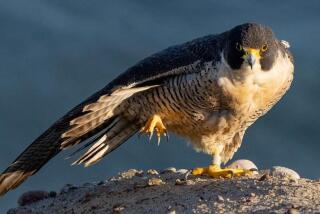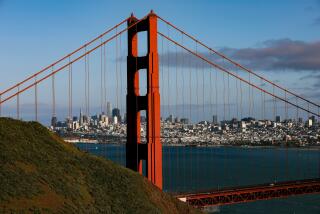Hungry Falcons Prey on San Francisco Pigeons
SAN FRANCISCO — It’s a jungle out there for the city-dwelling pigeon, and life is tough enough without the latest menace San Francisco’s birds must face--a 150-m.p.h. airborne attack from a pair of hungry peregrine falcons.
But experts say those attacks are probably occurring in the unfriendly skies over San Francisco’s financial district, as the feathered attack squadron launches strikes against the pigeons.
“Peregrines regularly prey upon birds, and city pigeons would suit them fine,” said Glenn Stewart, a member of the Predatory Bird Research Group at the University of California, Santa Cruz.
“The falcons make their captures only in flight. They can be going 100 to 150 m.p.h. when they hit a pigeon with their talons, then wheel to catch it. It’s all done so fast most people don’t even see it.
“A pigeon a day would keep them going quite nicely,” he added.
Frank Thorsberg, a public relations official for Pacific Gas & Electric Co., has been watching the birds--a mature male and an immature female--for some time and has gotten to know their habits.
“The falcons operate almost as regularly as clockwork,” said Thorsberg, who says the two birds stage attacks from an aerie on a sign near the top of the 31-story Mutual Benefit Life building.
“They alight on the . . . sign facing Drumm Street from 8:30 until 10 in the morning, then they take off. They’re back on their perch again in the afternoon from 3:30 to 5,” he said.
Stewart’s group has been reintroducing the rare predators to California and has released 300 falcons since 1977 in a state where only two pair had been reported--on the Monterey Peninsula. The falcons’ decline was linked to the now-banned pesticide DDT, blamed for causing thin eggshells.
Stewart said a dozen birds have been freed north of the city in Marin County. Since then, falcons have been spotted elsewhere in the city.
“The birds relate to building faces as they do to sheer cliffs in the wilds,” he said. “They have an abundant food supply: pigeons. And they don’t have to worry about the usual problem in the wild--getting shot.”
More to Read
Sign up for Essential California
The most important California stories and recommendations in your inbox every morning.
You may occasionally receive promotional content from the Los Angeles Times.










